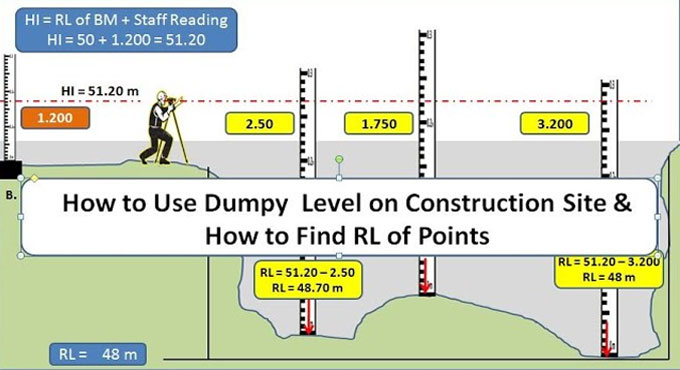NEWS | SOFTWARE | SHEET
Using a Surveying Dumpy Level in Construction: A Comprehensive Guide
A dumpy level, also known simply as a "level," is a type of optical instrument used in surveying and construction to measure horizontal levels and distances with high accuracy. It consists of a telescope mounted on a tripod. The essential components of a dumpy level include:
- Telescope: This is the primary component through which measurements are taken. It is equipped with crosshairs to assist in sighting and leveling.
- Leveling Bubble: Positioned on the instrument, this bubble helps in ensuring that the telescope is perfectly horizontal.
- Adjusting Screws: These are used to fine-tune the instrument and ensure that it is properly aligned.
- Graduated Scale: This is found on the leveling staff or rod, which is used in conjunction with the dumpy level to measure elevations.
How Does a Dumpy Level Work?
The operation of a dumpy level is straightforward yet precise. Here is a step-by-step guide on how it is typically used:
- Setting Up: The dumpy level is mounted on a tripod. The tripod legs are adjusted so that the instrument is roughly level. This is done by using the leveling screws to adjust the position of the instrument until the leveling bubble is centered.
- Sight the Target: The user looks through the telescope to align the crosshairs with a leveling staff positioned at a known point. The staff has measurements marked on it, which are read through the telescope to determine the height of the point.
- Take Readings: Once aligned, the user reads the measurement from the staff. By comparing the readings from different points, the user can determine the differences in elevation.
- Adjust for Accuracy: Fine adjustments are made to ensure that the instrument is perfectly level, and readings are taken again if necessary.
Applications of the Dumpy Level
The dumpy level has a variety of applications in construction and surveying. Some of the most common uses include:
- Setting Out: In the initial stages of construction, the dumpy level is used to set out reference points and establish horizontal benchmarks. This ensures that all subsequent construction aligns correctly with the planned design.
- Checking Levels: During construction, it is crucial to regularly check the levels of various components, such as foundations, floors, and walls. The dumpy level helps ensure that these elements are built to the correct specifications.
- Grading and Drainage: Proper grading is essential for effective drainage and to prevent water pooling. The dumpy level helps in measuring and adjusting the slope of surfaces to ensure that water flows away from structures.
- Aligning Structures: When installing components like railings, windows, or doors, the dumpy level ensures that these elements are perfectly horizontal, which is critical for both functionality and aesthetics.
Advantages of Using a Dumpy Level
Despite the emergence of more advanced technology, the dumpy level offers several advantages:
- Simplicity: The dumpy level is relatively simple to use. Its straightforward design allows for quick setup and operation, making it accessible even for those with limited experience.
- Durability: Constructed from robust materials, the dumpy level is built to withstand the rigors of construction sites. Its durability ensures that it remains reliable under various working conditions.
- Cost-Effectiveness: Compared to more advanced surveying instruments, the dumpy level is often more affordable. This makes it a cost-effective choice for many construction projects.
- Accuracy: The dumpy level provides high levels of accuracy, which is crucial for ensuring that construction work meets design specifications and standards.
- Versatility: The dumpy level can be used for a variety of tasks beyond construction, including landscaping and civil engineering, making it a versatile tool in the surveying toolkit.
Limitations of the Dumpy Level
While the dumpy level is a valuable tool, it does have some limitations:
- Limited Functionality: The dumpy level measures only horizontal levels and does not provide vertical measurements or angles, which are needed for more complex surveying tasks.
- Manual Operation: The dumpy level requires manual adjustments and readings, which can be time-consuming and prone to human error compared to digital instruments.
- Requires Skill: Accurate use of the dumpy level requires skill and experience. Incorrect setup or reading can lead to errors in measurements.
Modern Alternatives
In modern surveying and construction, several advanced tools have been developed that offer enhanced functionality compared to the dumpy level:
- Laser Levels: These use laser beams to provide highly accurate level readings and can cover a larger area compared to a dumpy level.
- Total Stations: These combine the functions of a theodolite with electronic distance measurement to offer a comprehensive surveying solution.
- Digital Levels: These provide automated readings and data storage, reducing the chances of human error and increasing efficiency.
The dumpy level remains a fundamental tool in construction and surveying due to its accuracy, simplicity, and cost-effectiveness. While modern technologies offer advanced features, the dumpy level’s robustness and reliability ensure its continued use in various applications.
Understanding how to properly use a dumpy level and recognizing its advantages and limitations will help construction professionals maintain precision and efficiency in their projects. As with any tool, mastering its use is key to leveraging its full potential and ensuring the success of construction endeavors.


